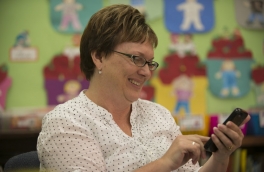School Funding
Our Kids Can't Wait
Strong schools work for our students, our communities, and Maryland. But right now in too many places in our state, kids don’t have the same access to a great education. As the state revises Maryland's school funding formula for the first time in nearly two decades, we have a once-in-a-generation opportunity to revamp and improve how Maryland funds our schools.
A 2016 study presented to the Kirwan Commission, a group of 25 education leaders tasked with revising the state’s funding formula, found that Maryland public schools are annually underfunded by $2.9 billion. That’s an average of $2 million in underfunding in each and every school in Maryland.
During the 2019 General Assembly session, legislators in Annapolis took important first steps, based on the work of the Kirwan Commission, to address the underfunding of our schools by passing the Blueprint for Maryland's Future. The bill increases education funding by $1.1 billion over the next three years to raise teacher pay and implement programs to help low-income and special education students. Thanks to the bill, teachers and other educators will see their largest raise since the 2008 recession. Schools will hire more special educators and paraprofessionals to help struggling learners and students with disabilities. More than 200 high-poverty schools will become community schools where wrap-around services such as counseling and healthcare will break down economic barriers to learning. This bipartisan legislation—on the heels of the March for Our Schools, the largest rally in Annapolis in nearly a decade—is a bold first step toward Maryland’s future success.
In November 2019—after three years of meetings, research, and public hearings about Maryland’s underfunded public schools—the Kirwan Commission held its final meeting and took its final votes. The commission's recommendations include proven measures such as expanding career technical education, community schools, and pre-k; increasing educator pay; hiring more educators to increase individual attention for students and to expand teacher planning and collaboration time; and providing more support for special education and mental health services. Phased in over 10 years, implementing these recommendations would lead to an additional $4 billion invested in public schools across Maryland.
The Kirwan Commission recommendations have been introduced in the 2020 General Assembly as HB 1000/SB 1300, the Blueprint for Maryland's Future. Legislators have until April 6, the final day of session, to debate, potentially amend, and vote on a new funding formula and how the Blueprint will be implemented and funded. Throughout session, MSEA will stay at the forefront of fighting for a significant increase in the resources and opportunities available to every student in Maryland.
For the latest news on school funding in Maryland, visit MSEA Newsfeed.
The Effects of Underfunding
The percentage of Maryland public school students living in poverty has more than doubled since 1990—from 22% to 45%—putting our statewide student population on the verge of becoming majority low-income. Since the last time the state funding formula was revised nearly 20 years ago, the percentage of English language learners, who require more staff and resources to catch up and stay on track with their English-speaking peers, has doubled. The number of students receiving special education services has also increased markedly. Maryland now ranks near the bottom of all states for funding poor districts and affluent district evenly, with federal education data showing that Maryland’s poorest school districts receive 5% less state and local education funding than Maryland’s wealthiest districts.
This underfunding has resulted in an increasing student to teacher ratio, meaning larger class sizes and less individualized instruction. Maryland teachers make 84 cents on the dollar compared to peers in similar fields with similar levels of education. Far too many support staff don’t make a living wage and must work multiple jobs to make ends meet. A statewide survey of educators in 2019 found that 50% of educators work a second job to make ends meet and 94% buy school supplies for their students out of their own pockets. Poll after poll has shown that Marylanders overwhelmingly want to close the funding gap in the state. For example, a September 2019 poll found that 71% of Marylanders said they favor the effort “to pass a school funding and policy plan that will significantly increase school funding."
Voters Overwhelmingly Pass Question 1 to Fix the Fund
When Marylanders approved casino gaming, voters thought the new revenue would increase education funding. But instead, Gov. O'Malley used $500 million of that money elsewhere in his budgets, followed by Gov. Hogan diverting $1.4 billion of casino money to plug holes in other parts of his budgets. In 2018, educators successfully fought for the passage of the Fix the Fund Act, which put a constitutional amendment on the November ballot (Question 1) to finally stop this budget gimmick and provide a $500 million annual increase in school funding. Question 1 passed overwhelmingly, with more votes than anything else on the ballot and by the widest margin of any Maryland ballot measure in more than 20 years. It's clear that Marylanders want increased funding for public schools, and Question 1 was the first step in making that a reality.
Related News
MSEA Statement on Veto of Blueprint for Maryland’s Future
“The governor’s veto is a disappointing but hopefully temporary setback. Now more than ever, we need the Blueprint for Maryland’s Future to create strong schools in every neighborhood by expanding career and technical education, providing additional support to struggling learners, and delivering a more prosperous future for our state. Our schools have been underfunded for years and recent weeks have only magnified the existing inequities that our students face every day that challenge their ability to succeed in school. We must come together to end these inequities that have underserved too many students and communities for too long. We urge the overwhelming number of legislators from both parties who voted for the Blueprint to override the veto at the next session of the legislature so we can deliver the support to our students that they desperately need," said Baltimore County elementary school teacher and Maryland State Education Association President Cheryl Bost.
Landmark Overhaul of Education Funding Passed by General Assembly
“The Blueprint is a once-in-a-generation opportunity to ensure that all of our students will benefit from the bill’s plan to expand career and technical education, hire more educators and pay them as professionals, give greater support to struggling learners, and commit to creating lasting educational equity and, ultimately, a more prosperous future for Maryland. We appreciate the work and bipartisan support of legislators to address the public health crisis we’re facing together and to advance this critical bill and achieve the goal of passing a new funding formula that better supports our students, educators, and schools," said MSEA President Cheryl Bost.
House Passes Landmark Overhaul of Education Funding
“Tonight legislators took a huge step toward realizing our once-in-a-generation opportunity to ensure that every student in every neighborhood has a great public school. The House’s action to pass the Blueprint for Maryland’s Future gets us closer to expanding career and technical education, hiring more educators and increasing their pay, providing additional support to struggling learners, and creating lasting educational equity and a more prosperous future for Maryland. Our kids can’t wait for the adequate and equitable school funding that they deserve—we must keep the momentum going and pass a new funding formula during the 2020 legislative session," said MSEA President Cheryl Bost.
MSEA Statement on Release of Blueprint for Maryland’s Future Legislation
“This is it: our once-in-a-generation chance to fundamentally improve our public schools and make sure that every student in every neighborhood has the opportunities, support, and attention that they deserve. The Blueprint for Maryland’s Future will lead to expanding career and technical education, hiring more educators and increasing their pay, providing additional support to struggling learners, and creating lasting educational equity and a more prosperous future for Maryland. Our kids can’t wait for the adequate and equitable school funding that they deserve—we must pass a new funding formula during the 2020 legislative session. Educators look forward to working with legislators to pass an equitable and sustainable formula that works for all students,” said Baltimore County elementary school teacher and MSEA President Cheryl Bost.
MSEA Statement on Kirwan Commission Final Vote on School Funding Formula
“This is a potentially game-changing moment for our students and our state—a once-in-a-generation opportunity to expand career and technical education, hire more educators and increase their pay, provide additional support to struggling learners, and create lasting educational equity and a more prosperous future for Maryland. Educators applaud the hard work of the Kirwan Commission and the leadership of Dr. Kirwan and look forward to working with the General Assembly to pass a new funding formula to ensure that every student in Maryland can attend a great public school. We must act during the 2020 legislative session because our kids can’t wait for the adequate and equitable school funding that they deserve," said Baltimore County elementary school teacher and MSEA President Cheryl Bost.


